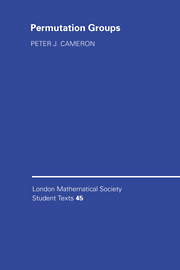5 - Oligomorphic groups
Published online by Cambridge University Press: 06 January 2010
Summary
The random graph
As we mentioned in Chapter 2, a random (labelled) graph on a given set X of vertices can be chosen by deciding, independently with probability 1/2, whether each unordered pair of points should be joined by an edge or not.
If |X| = n is finite, then every possible graph on n vertices occurs with positive probability. Moreover, the probability that the random graph is isomorphic to a given graph F is inversely proportional to the number of automorphisms of F. For the set of all graphs on X which are isomorphic to F is an orbit of Sn; and the orbit length is equal to n! divided by the order of the stabiliser of F (this stabiliser being just Aut(F), as in Section 2.3). For infinite sets, however, the picture is very different. The following paradoxical result was observed by Erdos and Rényi in 1963.
Theorem 5.1There is a countable graph R with the property that, with probability I, a countable random graph is isomorphic to R.
And we will see that, in sharp contrast to the finite case, R has a very large automorphism group.
Proof. The proof follows immediately from two facts below. First, we say that a graph F has property (*) if the following is true:
For any two finite disjoint sets U and V of vertices, there exists a vertex z joined to every vertex in U and to no vertex in V.
We defer for a moment the question whether any graphs satisfying property (*) actually exist.
- Type
- Chapter
- Information
- Permutation Groups , pp. 131 - 164Publisher: Cambridge University PressPrint publication year: 1999



